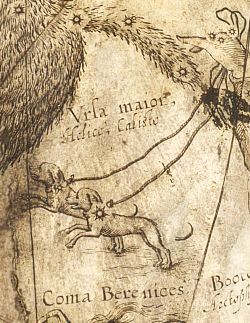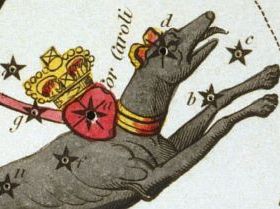Wikipedia
R.H. Allen:
Star Names
Ian Ridpath:
Star Tales
Universe Guide
Sea and Sky:
Constellations
SkyEye:
Constellations
IAU
Map
NASA:
Constellations
|
Wikipedia |
R.H. Allen: Star Names |
Ian Ridpath: Star Tales |
Universe Guide |
Sea and Sky: Constellations |
SkyEye: Constellations |
IAU Map |
NASA: Constellations |


|
|
Star LoreCanes VenaticiThe Hunting Dogs |
|


|
Canes Venatici is a small constellation in the northern hemisphere.
It was one of seven new constellations designed by Polish astronomer Johannes Hevelius in 1687. |


|
|
For a brief overview of the main stars of the constellation, click the
Astronomy icon.
 For an alphabetic listing of the constellation's main object in different cultures, click the Index icon. |
|


The constellation is made of faint stars between the classical Ptolemaic
constellations Ursa Major
and Boötes.
 The transition of these previously uncategorized stars into two hunting dogs not mentioned in Greek mythology came through a translation errors: |

| In ancient descriptions, the Herdsman Boötes was shown with a shepherd’s crook. In the Arabic translation of Ptolemy's Almagest, the crook was called al-'aşā dhāt al-kullāb (العصا ذات الكُلاب), a staff having a hook. |

| In 1175, Gerard of Cremona of the Toledo School of Translators translated an Arabic version of the Almagest into Latin. Arabic star name expert Paul Kunitzsch concluded that Gerard mistook the word الكُلاب al-kullāb (hook) for the word الكِلاب al-kilāb (dogs) as, without diacritics, both words are spelled alike. |

|
 Apianus, 1536; source: Iand Ridpath
Apianus, 1536; source: Iand Ridpath |
 Blaeu, 1602; source: Iand Ridpath
Blaeu, 1602; source: Iand Ridpath
|
 However, only a year later, on Blaeu's next globe, the dogs had disappeared. Ian Ridpath speculates that "... Blaeu perhaps learned that the dogs shown by Apianus were due to a mistranslation..." |


|
|
The Jordan River
 With the uncategorized stars around Ursa Major being back up for grabs, another Dutch cartographer, Petrus Plancius turned them into the constellation Jordanis, on some maps called Jordanus or Jordanus Fluvius.  In Plancius' design, the river originated at a star now known as Cor Caroli or α Canum Venaticorum and ended near the constellation Camelopardalis, - another one of Plancius' creations. Plancius' introduced his constellations on a globe in 1612 and throughout the 17th and 18th centuries, the Jordan River would flow through several star maps, until Johannes Hevelius replaced it with several constellations of his own design.  Sources: John C. Barentine: The Lost Constellations, Ian Ridpath, Wikipedia |

|


|
|
The Borgian Globe
 The Borgian Globe is an Arabic celestial globe manufactured in 1225 and recovered in 1790 by Cardinal Stefano Borgia. It shows the Ptolemaic constellations, inscribed in Kufic characters.  In addition, it shows two constellations not shown on any other globe. One is an oval shape, enclosing eight stars in the location of the modern constellations Leo Minor and Lynx.  The other one is a square underneath the "Tail" of Ursa Major at the location of Canes Venatici.  |
 karab alebl on the Borgian Globe
karab alebl on the Borgian GlobeSource: atlascoelestis.com |
 R.H. Allen, referring to orientalist Assemani, called the formation al karb al ibl, the Camel's Burden. Felice Stoppa called it karab alebl, the Camel Pack.  Sources: R.H. Allen, atlascoelestis.com |


|
|
The Sultan's Tables
 In 1439, Timurid sultan and astronomer Ulugh Beg set a new standard in astronomical observation publishing the Sultan's Tables or Zij-i-Sultani.  In it, he called the star later known as α CVn Al Kabd al Asad. The name literally means "The liver of the Lion", referring to the Arabic celestial complex al Asad, the Lion. However, "Liver" in this case is not a biological term, but a technical one. According to R.H. Allen, it indicates "... the highest position of any star within the compass of a figure reckoned from the equator."  Source: R.H. Allen |


|
|
Cor Caroli - The Heart of the martyred King
 Between 1642 and 1651, England was torn apart by a Civil War between Royalists and Parliamentarians. One of the main events of that war was the beheading of King Charles I in 1649.  In 1673, English mapmaker Francis Lamb published a book called "Astroscopium", which contained maps of the two celestial hemispheres. In the northern hemisphere, between the constellations Ursa Major, Boötes and Coma Berenices, Lamb labeled the brightest of the uncategorized stars Cor Caroli Regis Martyris - the heart of Charles the martyred king.  Lamb and others after him drew a red heard around the star and adorned the heart with a crown. Until Hevelius's Canes Venatici took the place between the Bear and the Herdsman, the single star that was to become α Canum Venaticorum took the place of a unique single-star constellation. Later, when the Hunting Dogs took their place, the star was still shown with heart and crown on the collar of the southern dog.  In 2016, the IAU's Working Group on Star Names registered Cor Caroli as the official name of α CVn, making it the only star visible to the naked eye that is named after a real historical person.  Sources: Ian Ridpath, Wikipedia |

 The execution of King Charles I, 1649
The execution of King Charles I, 1649Source: National Portrait Library |
 1700 celestial globe by Thomas Tuttell
1700 celestial globe by Thomas TuttellSources: Iand Ridpath, British Library |
 Uranias Mirror, 1874
Uranias Mirror, 1874Source: Wikipedia |


|
|
Between 1641 and 1687, Polish astronomer Johannes Hevelius and his second wife
Elisabeth compiled data of 1,564 stars - the largest number ever observed with the naked eye.
 A star catalogue called Catalogus Stellarum Fixarum and a star atlas called Firmamentum Sobiescianum were published by Elisabeth Hevelius in 1690, three years Johannes Hevelius' death. They contained ten new constellations, seven of which are still used today. |

|
 Boötes & Canes Venatici
Boötes & Canes VenaticiAstrophilogeon, 1828 |


|
|
Chinese Astronomy
In Chinese, Canes Venatici is written
獵 犬 座.
|
 Philosopher Mencius advising the emperor
Philosopher Mencius advising the emperorSource: China Federation of Literary and Art Circles
|


|
|
Whirlpool Galaxy
 since from Earth, it can be seen "face on", the Whirlpool Galaxy was the first object in which the spiral structure, typical for many galaxies, was observed.  In 1845, Anglo-Irish astronomer William Parsons, 3rd Earl of Rosse observed what was then known as a "nebula" and noticed its spiral structure. His precise drawing was the first closeup image of a galaxy.  Sources: Wikipedia, NASA |

|


|
|
In the 2019 NameExoWorld project, in which each country on earth could name one star and one exoplanet, one star and planet in the constellation Canes Venatici received a proper name. |

  |
Ireland chose names that showcases both its national folklore and the hunting dog theme of the constellation.
 The hunting dogs of Irish mythical hunter-warrior Fionn mac Cumhaill were once humans. Fionn's aunt Tuiren and her sons Bran and Sceolang were turned into hounds by the jealous fairy Uchtdealbh.  The star HAT-P-36 was named Tuiren; its planet HAT-P-36 b was named Bran.  Sources: NameExoWorlds Approved Names, theirishroadtrip.com |
 Fionn MacCumhaill and his Hounds
Fionn MacCumhaill and his HoundsStatue by Lynn Kirkham; Source: kildare.ie
|


|
Back to Star Lore |
Back to Mythology |
 Back to Hevelius |
Back to Space Page |
Back to English |
 Back to Start Page |